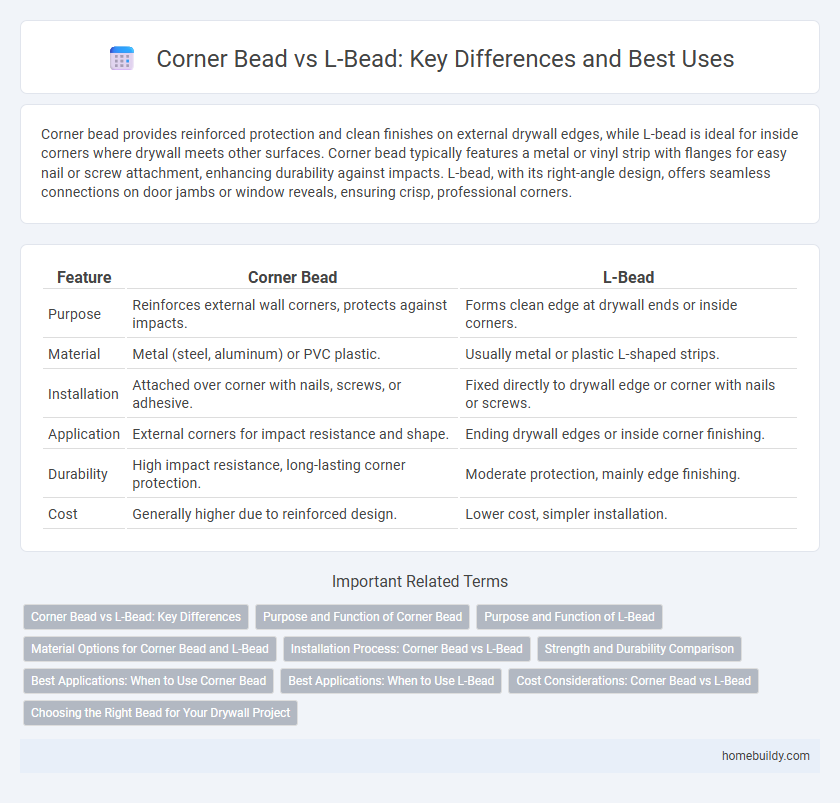Corner bead provides reinforced protection and clean finishes on external drywall edges, while L-bead is ideal for inside corners where drywall meets other surfaces. Corner bead typically features a metal or vinyl strip with flanges for easy nail or screw attachment, enhancing durability against impacts. L-bead, with its right-angle design, offers seamless connections on door jambs or window reveals, ensuring crisp, professional corners.
Table of Comparison
| Feature | Corner Bead | L-Bead |
|---|---|---|
| Purpose | Reinforces external wall corners, protects against impacts. | Forms clean edge at drywall ends or inside corners. |
| Material | Metal (steel, aluminum) or PVC plastic. | Usually metal or plastic L-shaped strips. |
| Installation | Attached over corner with nails, screws, or adhesive. | Fixed directly to drywall edge or corner with nails or screws. |
| Application | External corners for impact resistance and shape. | Ending drywall edges or inside corner finishing. |
| Durability | High impact resistance, long-lasting corner protection. | Moderate protection, mainly edge finishing. |
| Cost | Generally higher due to reinforced design. | Lower cost, simpler installation. |
Corner Bead vs L-Bead: Key Differences
Corner bead provides reinforced protection and a clean finish to external drywall corners, featuring a rigid metal or plastic profile that wraps both sides of the corner for durability. In contrast, L-bead is designed specifically for drywall terminations where one side meets the edge of a wall or opening, offering a single flange for a neat, discreet edge. Understanding the distinct applications and structural designs of corner bead versus L-bead is essential for selecting the right trim in drywall installation and repair projects.
Purpose and Function of Corner Bead
Corner bead is designed to reinforce drywall corners, providing a crisp, clean edge that resists impacts and prevents cracking. Its primary function is to protect vulnerable corners during construction and everyday wear, enhancing durability and ensuring a professional finish. Unlike L-bead, which covers only one drywall edge, corner bead wraps around the external corner, offering comprehensive protection and structural support.
Purpose and Function of L-Bead
L-bead is primarily designed to provide a clean, finished edge on drywall corners where the sheet meets a different surface, such as a window or door frame, ensuring durability and aesthetic appeal. Unlike corner bead, which reinforces external corners, L-bead secures drywall edges while preventing cracks and chips by creating a sharp, defined angle. Its function also includes supporting joint compound for a smooth transition, enhancing both structural integrity and visual quality in interior wall installations.
Material Options for Corner Bead and L-Bead
Corner bead and L-bead are available in various material options such as galvanized steel, aluminum, vinyl, and paper-faced fiberglass, each offering different levels of durability and flexibility. Galvanized steel corner beads provide superior strength and resistance to rust, making them ideal for heavy-duty applications, while vinyl options offer corrosion resistance and ease of installation in humid environments. L-bead materials often match corner bead choices, with aluminum favored for lightweight framing and vinyl preferred in moisture-prone areas to prevent warping and corrosion.
Installation Process: Corner Bead vs L-Bead
The installation process of corner bead involves attaching a rigid metal or vinyl strip along outside corners of drywall to provide protection and sharp edges, typically fastened with nails, screws, or adhesive. L-bead, designed for inside or outside corners, uses a similar installation method but offers more flexibility for curved or non-standard angles, often requiring careful alignment before securing. Both require mudding and sanding for finishing, but corner bead installation is generally quicker for standard right angles while L-bead demands precision in fitting irregular corners.
Strength and Durability Comparison
Corner beads, made from materials like galvanized steel or PVC, offer superior strength and durability compared to L-beads, which are typically made of thinner metal or plastic. The robust construction of corner beads provides enhanced protection against impacts and cracking along drywall corners, ensuring long-lasting performance. In environments prone to heavy wear and tear, corner beads maintain edge integrity more effectively than L-beads.
Best Applications: When to Use Corner Bead
Corner bead is best used for exterior drywall corners requiring durable, crisp edges that can withstand impact and are easy to finish with joint compound. Unlike L-bead, which is ideal for ending drywall at doorways or windows without overlapping the adjoining surface, corner bead excels in reinforcing outside corners in high-traffic areas such as hallways and living rooms. Its metal or vinyl construction provides superior protection and long-lasting sharp lines, making it the preferred choice in construction and remodeling projects seeking clean, resilient corner finishes.
Best Applications: When to Use L-Bead
L-bead is ideal for finishing drywall edges where traditional corner beads are unsuitable, such as around window frames, door jambs, and other irregular or non-90-degree angles. Its design provides a clean, sharp edge while protecting drywall corners prone to damage in these unique applications. L-bead outperforms corner bead in scenarios requiring precise edge protection and aesthetic appeal on angular or non-standard surfaces.
Cost Considerations: Corner Bead vs L-Bead
Corner bead typically costs more than L-bead due to its reinforced metal or vinyl design that provides greater durability and protection for drywall corners. L-bead is a more economical option, made from lighter materials and used mainly for edge finishing rather than corner reinforcement. When budgeting for drywall projects, choosing L-bead offers cost savings, but corner bead delivers long-term value by reducing damage and maintenance expenses.
Choosing the Right Bead for Your Drywall Project
Selecting the ideal drywall finishing component requires understanding the differences between corner bead and L-bead. Corner bead is typically used for reinforcing and shaping outside corners, offering durability and a clean, sharp edge, while L-bead is designed for inside corners or where drywall ends meet other surfaces. Choosing the right bead depends on your project's specific corner type and desired finish quality, ensuring optimal protection and aesthetic appeal.
corner bead vs L-bead Infographic

 homebuildy.com
homebuildy.com